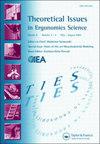Representativity and univocity of traffic signs and their effect of trajectory movement in a tracking task: informative signs
IF 1.4
Q4 ERGONOMICS
引用次数: 1
Abstract
Abstract The importance of how cognitive processes (Reasoning) influence on the understanding and the mental representation of road-side elements in form of the movement effects on the path driving must be studied in-depth. Literature shows that the key point to explain the influence of attention on movement is the meaning of the object being processed; literature also shows that the Reasoning with those cues we pay attention to has an effect on driving. By using a driving-simulation task, traffic signs have been tested on their effect on movement. Results show that the least-representative-of-their-meaning signs deviate participants´ movement path more intensively than the most-representative-of-their-meaning signs. Conclusions: Traffic accidents are well-known for their. The results here reported help to improve the cognitive Ergonomics of every road element, specially, traffic signs.交通标志的代表性和唯一性及其对跟踪任务中轨迹移动的影响:信息标志
摘要:认知过程(推理)如何以道路驾驶的运动效应的形式影响对路边要素的理解和心理表征,必须深入研究。文献表明,解释注意对运动影响的关键是被加工对象的意义;文献还表明,我们所关注的这些线索的推理对驾驶有影响。通过驾驶模拟任务,测试了交通标志对运动的影响。结果表明,最不具代表性的意义符号比最具代表性的意义符号更严重地偏离了参与者的运动路径。结论:交通事故是众所周知的。这里报告的结果有助于提高每个道路元素的认知人机工程学,特别是交通标志。
本文章由计算机程序翻译,如有差异,请以英文原文为准。
求助全文
约1分钟内获得全文
求助全文

 求助内容:
求助内容: 应助结果提醒方式:
应助结果提醒方式:


